Hello and welcome back to another edition of Ultra Budget Brews, the monthly article series that builds entire Commander decks in which no card costs more than $1.
Every week, I give you all a poll so that you all have some say in what these articles end up being about. If I'm writing about things that are only interesting to me, I'm basically shouting into the void for shouting sake. If I'm writing about things that you all are interested in, I'm still shouting into the void, but at least others are listening. Normally, the poll includes a couple of commanders for you to vote on, which makes my job pretty easy. Last time, I decided to change things up. Instead of giving you all a bunch of legendary creatures to vote on, I gave you cards that might inspire you to build a deck. The cards you were given were as follows:





There we're a few votes, not a ton, with Door to NothingnessDoor to Nothingness leading the way. Mentally, I started brewing a deck around this when I read back through the comments and came across a comment from user Halfdan Temple saying I should just shove all 5 of the cards into a 5 color ProgenitusProgenitus deck. It's entirely possible they we're being sarcastic, but I decided to run with it, partly because it sounded kind of awesome, and partly because I had just built an almost identical deck in paper.
Unfortunately, we won't be able to use ProgenitusProgenitus as the commander, as it costs too much. In fact, most of the 5-color commanders cost too much. We are left with 5 options: AtogatogAtogatog, Karona, False GodKarona, False God, General TazriGeneral Tazri, Horde of NotionsHorde of Notions, and Jodah, Archmage EternalJodah, Archmage Eternal. None of the above directly effect the deck we want to build.
- Horde of NotionsHorde of Notions and AtogatogAtogatog want to be Elemental and Atog tribal.
- General Tazri can be Tribal Allies, but often gets built as a very competitive Food ChainFood Chain combo deck, which could draw a ton of hate.
- Jodah, Archmage EternalJodah, Archmage Eternal typically gets built as a weird hybrid of all the extra turns/Eldrazi tribal deck, which will also draw some amount of hate. Unless we are playing tribal (spoiler alert: we're not)
- Karona, False GodKarona, False God helps our opponents more than it helps us.
I narrowed it down to AtogatogAtogatog and Horde of NotionsHorde of Notions. I realized that I'd only play AtogatogAtogatog if I wanted to seem really unique or to get a few laughs, which is admittedly a fine thing to do. EDH allows for a lot of self-expression, which is one of the reasons it's as popular as it is. I'm just choosing to express myself by giving myself a plausible alternate route to victory, bashing my opponents to death with Horde of NotionsHorde of Notions.
The Maze Runner
View on Archidekt- 1 [Commander]Horde of Notions[/Commander][Commander]Horde of Notions[/Commander]
Land (45)
- 1 Arcane SanctumArcane Sanctum
- 1 Azorius GuildgateAzorius Guildgate
- 1 Boros GuildgateBoros Guildgate
- 1 Command TowerCommand Tower
- 1 Crumbling NecropolisCrumbling Necropolis
- 1 Dimir GuildgateDimir Guildgate
- 1 Evolving WildsEvolving Wilds
- 8 ForestForest
- 1 Frontier BivouacFrontier Bivouac
- 1 Gateway PlazaGateway Plaza
- 1 Golgari GuildgateGolgari Guildgate
- 1 Gruul GuildgateGruul Guildgate
- 3 IslandIsland
- 1 Izzet GuildgateIzzet Guildgate
- 1 Jungle ShrineJungle Shrine
- 1 Maze's EndMaze's End
- 3 MountainMountain
- 1 Mystic MonasteryMystic Monastery
- 1 Nomad OutpostNomad Outpost
- 1 Opulent PalaceOpulent Palace
- 1 Orzhov GuildgateOrzhov Guildgate
- 3 PlainsPlains
- 1 Rakdos GuildgateRakdos Guildgate
- 1 Sandsteppe CitadelSandsteppe Citadel
- 1 Savage LandsSavage Lands
- 1 Seaside CitadelSeaside Citadel
- 1 Selesnya GuildgateSelesnya Guildgate
- 1 Simic GuildgateSimic Guildgate
- 3 SwampSwamp
- 1 Terramorphic Expanse[/Land]Terramorphic Expanse[/Land]
Instant (15)
- 1 Abzan CharmAbzan Charm
- 1 Arcane DenialArcane Denial
- 1 Bant CharmBant Charm
- 1 Crackling DoomCrackling Doom
- 1 Esper CharmEsper Charm
- 1 Grixis CharmGrixis Charm
- 1 Jeskai CharmJeskai Charm
- 1 Jund CharmJund Charm
- 1 Mardu CharmMardu Charm
- 1 MortifyMortify
- 1 Nature's ClaimNature's Claim
- 1 Naya CharmNaya Charm
- 1 Rakdos CharmRakdos Charm
- 1 Sultai CharmSultai Charm
- 1 Temur Charm[/Instant]Temur Charm[/Instant]
Enchantment (14)
- 1 Axis of MortalityAxis of Mortality
- 1 Crackling PerimeterCrackling Perimeter
- 1 Dictate of KruphixDictate of Kruphix
- 1 Fevered VisionsFevered Visions
- 1 Guild SummitGuild Summit
- 1 Honden of Cleansing FireHonden of Cleansing Fire
- 1 Honden of Infinite RageHonden of Infinite Rage
- 1 Honden of Life's WebHonden of Life's Web
- 1 Honden of Night's ReachHonden of Night's Reach
- 1 Honden of Seeing WindsHonden of Seeing Winds
- 1 Into the WildsInto the Wilds
- 1 Marchesa's DecreeMarchesa's Decree
- 1 Sultai AscendancySultai Ascendancy
- 1 Swarm Intelligence[/Enchantment]Swarm Intelligence[/Enchantment]
Artifact (3)
- 1 Commander's SphereCommander's Sphere
- 1 Door to NothingnessDoor to Nothingness
- 1 Ghirapur Orrery[/Artifact]Ghirapur Orrery[/Artifact]
Sorcery (14)
- 1 Approach of the Second SunApproach of the Second Sun
- 1 Bring to LightBring to Light
- 1 Circuitous RouteCircuitous Route
- 1 Diabolic TutorDiabolic Tutor
- 1 DuneblastDuneblast
- 1 ExploreExplore
- 1 Painful TruthsPainful Truths
- 1 Read the BonesRead the Bones
- 1 Reap and SowReap and Sow
- 1 RoutRout
- 1 Sylvan ScryingSylvan Scrying
- 1 Urban EvolutionUrban Evolution
- 1 Villainous WealthVillainous Wealth
- 1 Wildest Dreams[/Sorcery]Wildest Dreams[/Sorcery]
Creature (8)
- 1 Coiling OracleCoiling Oracle
- 1 Jodah, Archmage EternalJodah, Archmage Eternal
- 1 Den ProtectorDen Protector
- 1 District GuideDistrict Guide
- 1 Felidar SovereignFelidar Sovereign
- 1 Gatecreeper VineGatecreeper Vine
- 1 Realm SeekersRealm Seekers
- 1 Tatyova, Benthic Druid[/Creature]Tatyova, Benthic Druid[/Creature]
Card Kingdom cost: $27.95
A Quick Budget Buiding Aside
While going through the writing process, this deck changed more than any other I have ever written about. At first, I tried to jam all of the cards from the poll into the deck, including ways to make Finest HourFinest Hour and Shaman of the Great HuntShaman of the Great Hunt work. The deck ended up a discombobulated mess. Most of the deck didn't care about attacking, but a small subsection of the cards only worked if the deck was aggressively attacking. As a result, this build got scrapped.
Another thing I've always wanted to do is play a deck that jams as many alternate win conditions into a deck as possible. The problem with this is threefold: many of the best alternate win conditions are too expensive for our purposes, the alternate win conditions we do have access to are pretty difficult to pull off to begin with, and none of them synergize with each other. A deck playing Barren GloryBarren Glory, Near-Death ExperienceNear-Death Experience, Felidar GuardianFelidar Guardian, Liliana's ContractLiliana's Contract, Mayael's AriaMayael's Aria and Azor's ElocutorsAzor's Elocutors literally wants to do 7 entirely unrelated things. It could conceivably work in a deck with a ton of tutors to fetch up the exact piece you need at the exact moment you need it, but most tutors are too expensive and without them, the deck is an actual dumpster fire a solid 95% of the time, and that's being very generous.

I can sort of see Barren Glory peaking out there
I tell you all of this not to complain about how hard it is to write articles about building budget decks, but rather as a word of caution. If you are someone that is building on a budget, you have a finite amount of resources, whether that's money, cards to trade, or some combination of the two. You likely don't have the resources to have multiple false starts like I just described above. Trading that Assassin's TrophyAssassin's Trophy you opened at the prerelease for a bunch of cards that you aren't actually going to end up playing leads to a horrible case of the feelbads. So, figure out what you are actually going to play ahead of time, perhaps by building the deck on MtgGoldfish, so that you can acquire cards with confidence.
The A-maze-ing Maize Maze
So, after building (and scrapping) two terrible decks, I am left with a deck that resembles something I (coincidentally) just built in paper. We're racing to the Maze's EndMaze's End, baby.

"I wanna go fast!"
I've always wanted to build a deck in paper built around gates, but there were just too few cards that interacted favorably with gates for me to actually put the capital in to doing so. Return to Return to Ravnica changed that.




Try to say the name of this card 5 times fast
Do these cards suddenly make Maze's EndMaze's End competitive? No, not really. What they do is give more tools to be able to build a deck that does what you are wanting to do with more consistency. Also, the inclusion of these cards make me hopeful that more 'gates-matters' cards will be included in the next two sets.
A significant amount of the cards in the deck enable us to find lands or to play extra lands. Many of the usual suspects like FarseekFarseek and CultivateCultivate don't make the cut here simply because they only fetch basics or cards with a specific land type. Our deck wants cards that search for 'any land.' Most of these are outside of our budget, thanks to their synergy with cards like Cabal CoffersCabal Coffers and Gaea's CradleGaea's Cradle, but a few very good options remain. Sylvan ScryingSylvan Scrying can find our[/card]Maze's End[/card] or whatever other gate we might be looking for. Reap and SowReap and Sow works as land tutor, ramp, and land destruction. Realm SeekersRealm Seekers is a perpetually underrated card that is fantastic in this role as well.
Related to the above, we are playing a ton of lands: 45 altogether. This may seem like too many, but the reason for this is because we never want to miss a land drop, and we will be searching for quite a few lands as the game goes on. I've had a fair amount of luck with 45 thus far, but if you really wanted, you could probably get away with dropping a few lands, with 42 being the lower limit of what I'd play.
One of the great things about playing all 5 colors is being able to play any card we want, meaning we have access to every conceivable effect. In recognition of this fact, I added a charms package,including all of the tricolored charms from Khans of Tarkir and Shards of Alara. Running all 10 of these allows the deck a ton of flexibility, adapting to whatever situation might come up. Bring to LightBring to Light is in the deck specifically because it allows you to find whichever tool you might need in a particular situation.

The deck also has all of the Hondens. These are legendary shrines that have an upkeep effect dependent on how many shrines you have on the board. These range from very powerful (Honden of Seeing WindsHonden of Seeing Winds and Honden of Night's ReachHonden of Night's Reach) to very average (Honden of Cleansing FireHonden of Cleansing Fire), but all of them are great once you get 2 of them on the field at the same time. I've always wanted to find a deck to run these, and this one seems like the place, as they work best in a deck that wants the game to last a bit longer than normal.
You'll also notice that there are a few holdovers from the 'Alternate win-con' tribal iteration of the deck. Approach of the Second SunApproach of the Second Sun and Felidar SovereignFelidar Sovereign both give our deck ways to win if someone is hellbent on blowing all of our lands up. Axis of MortalityAxis of Mortality, while not exactly a win con, is a card I've always wanted to play and is a great way to incentivize opponents to attack elsewhere.
Notable Inclusions
Tatyova, Benthic DruidTatyova, Benthic Druid

I had seen this card talked about a lot, and had even played against it, but never really got what the fuss was; I don't often play Simic colors, so it's not a card I had actually cast. Two weeks ago, I finally did.

This card is absolutely insane. Why is this an uncommon? Why does it trigger whenever a land enters the battlefield instead of whenever you play a land? Why do (apparently) only SImic aficionados get to design cards? Clearly I don't understand a lot of things. What I do understand is that you should be playing this card.
DuneblastDuneblast
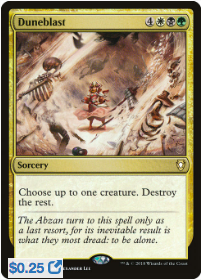
This card costs 7 mana, which is admittedly a lot. There are a couple of things going for it here, some obvious, others less obvious. First, the obvious. If you have a creature you really want to live, you get to keep it.

There aren't a ton of creatures in the deck, but getting to keep a Realm SeekersRealm Seekers seems like a good way to win the game. One less obvious thing about this card is that you can use it to garner a significant amount of favor with a single opponent. People don't like having their creatures destroyed. Make a temporary alliance with someone by sparing their most important creature. All you need with this deck is time. Unless you are getting a bit lucky, Maze's EndMaze's End is a slow card, but it will get there given enough turns. Turning an enemy into less of an enemy may buy you just enough time to win.
Door to NothingnessDoor to Nothingness
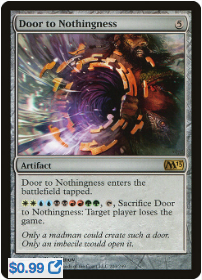
We don't play any artifact shenanigans, but this card is fun. You only get to play this in a 5 color deck, and sometimes, you just need to end the game. It's the definition of a fair card, coming in to play tapped, and costing a total of 15 mana to use, including at least two of every color. If your opponents don't have an answer, show them the Door.

I can practically taste your eye rolls
In the deck I built, I play all of the Bringer cycle, because why not, and one of the things I am excited to achieve is pairing this up with a Bringer of the White DawnBringer of the White Dawn.
Into the WildsInto the Wilds
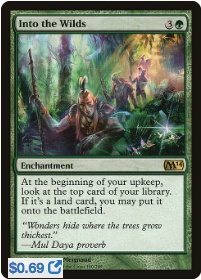
As noted above, we are playing 45 lands, meaning this card will trigger roughly half of the time. That's a solid amount. This card is pretty innocuous, meaning your opponents are unlikely to remove it. The only time they are likely to remove it is if they see you getting a ton of value out of it. If that's happened, then the card has been well worth the 4 mana you spent. Sure, there will be some games that this will hit brick after brick, but there are also games where you draw 10 lands in a row. That's just variance, and variance is Magic.
Wildest DreamsWildest Dreams

One thing that this decktype struggles against is land destruction. If your opponent is playing a bunch of JokulhapsJokulhaps and ArmageddonArmageddon, it might be time to pull out a different deck, but if they are playing cards like Ghost QuarterGhost Quarter or Field of RuinField of Ruin (which are things most decks should be running), you need a way to get your gates and Maze's EndMaze's End back. This card isn't quite as efficient as Eternal WitnessEternal Witness or Sun TitanSun Titan, but it's also less restricted, can go a lot bigger, and costs a quarter. You'll often use it to get key lands back, but you can even use it to get removal, ramp, or threats back. Recursion won't always feel important, but when it is, it's often game winning.
Notable Exclusions
As always, these are the cards I would include if I we're looking to up the power level of the deck, wasn't interested in a strict budget restriction, or had a copy or two lying around.
Rites of FlourishingRites of Flourishing

If there is one card I'd add to this deck, this would be the one. Being able to play two lands a turn is very important and very powerful. Being able to play a land, use your Maze's EndMaze's End ability and then replay the Maze's EndMaze's End is fantastic. Card draw is always nice, more so for our deck since we are playing so many lands. It also makes your opponents a bit less likely to attack you, since they probably appreciate the extra resources.
Crop RotationCrop Rotation

I could wax philosophical about this card, but its pretty straight forward. It finds you any land at the cost of a land, at instant speed. It's great in this deck.
Hour of PromiseHour of Promise
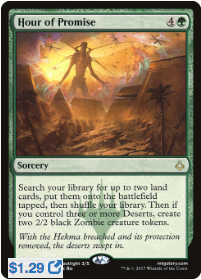
We aren't playing any deserts in this deck, but the first part is plenty good enough to warrant a spot. This either finds your Maze's EndMaze's End with an additonal gate, or finds you 20% of your wincon. Perfect.
Seasons PastSeasons Past
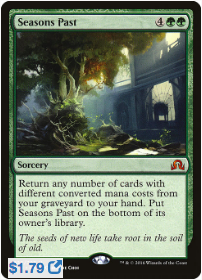
This is the card that Wildest DreamsWildest Dreams hopes to be when it grows up. It gets back a ton of cards for you to use, though it can only get a single land. Hopefully that's all you need.
ScapeshiftScapeshift

In something that I feel is becoming a mantra of my articles, sometimes games need to end. This will do the trick nicely. Tap some basics to pay for the cost, sacrifice how ever many lands you need to find the gates you need, and win on the spot (assuming you have a Maze's EndMaze's End in play already). It's a pricy card but, thankfully, not near as pricy as it was a few months ago. This is probably the second card I'd add to the deck.
End Step
What do you think about this deck? Is it something you'd sleeve up and play? I've gotten to jam a fair amount of games with my version of this deck and it's been a blast. You won't win every game, but you will win some amount, and when you do, well, your opponents just got beat by Maze's EndMaze's End. As always, vote in the comments for which deck you'd like to see next week.


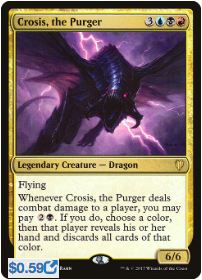
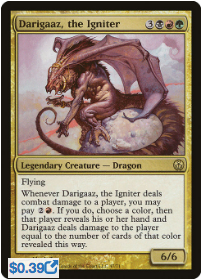

(Sorry, just imagine Merieke Ri BeretMerieke Ri Beret is more dragon-y. Dromar, the BanisherDromar, the Banisher costs too much)
Until next time!
Andrew Cummings
Andrew is a life-long gamer and has been playing Magic since 2013. He works as an ASL interpreter, enjoys running, and sitting on his porch reading, while simultaneously silently judging his neighbors. He lives in Joplin, MO with his wife.
Your opinions are welcome. We love hearing what you think about Magic! We ask that you are always respectful when commenting. Please keep in mind how your comments could be interpreted by others. Personal attacks on our writers or other commenters will not be tolerated. Your comments may be removed if your language could be interpreted as aggressive or disrespectful. You may also be banned from writing further comments.
